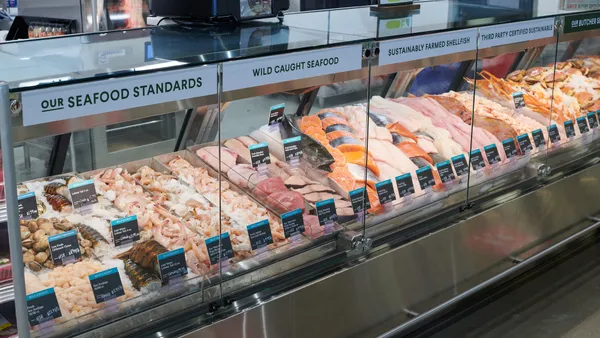Regenerative agriculture has grown in popularity as a strategy for decarbonizing our food system. While it can help mitigate agriculture’s climate impacts, its importance is much greater -- as regenerative agriculture plays a critical role for building the resilience of our food system to feed a growing global population.
By 2050, global food production will need to increase by 70%, to meet demands from the world’s ever-increasing population. At the same time, climate change – along with other constraints on land, water and other natural resources– continues to pressure farmers and others throughout the food industry already dealing with constant supply chain disruptions and market volatility.
Regenerative agriculture can offer a promising solution. However, if we only consider the climate mitigation factor – and not the broader environmental and economic benefits – we’ll not only lose sight of a food-secure future, we’ll also miss the solutions needed to effectively scale-up regenerative agriculture.
Food system resiliency starts with the farmer. To help drive adoption of regenerative agriculture, our industry must support farmers through the transition.
When we launched Cargill RegenConnect® four years ago, we worked closely with farmers to design a regenerative agriculture program built around their needs. It had to be practical, flexible and customizable, but more importantly address the economic risks associated with transitioning to regenerative agriculture.
We believe that approach is working. We’ve enrolled 1 million acres across 24 states in the U.S for the 2025 growing season. We’ve also added more commodities and launched similar regenerative agriculture programs in Brazil, Australia and six European countries. Along the way we’ve engaged growers through conversations, field events and surveys to help us refine the program and better understand what drives farmer adoption.
What knowledge have we gained from working with farmers on regenerative agriculture programs? And how can these learnings be applied to other companies in the food and agriculture industry?
Here are three key learnings:
- Regenerative agriculture is more than decarbonization – While mitigating carbon emissions is critical, we must think more broadly. Regenerative agriculture offers a way to build resilience into the food and agriculture system by helping farmers adapt to climate change, improve farm economics and build healthy soils for future generations. Practices like cover crops and reduced tilling can increase biodiversity and help the soil retain more water. In a study conducted by the Soil Health Institute, 97% of farmers who adopted regenerative agriculture practices reported increased crop resiliency to extreme weather. We must build the business case for regenerative agriculture around these diverse outcomes.
- A farmer-centric approach is critical to driving support and adoption – For some farmers, adopting these practices is a major adjustment to their operations. The process needs to be easy, and programs need to offer flexibility and support – both financial and technical. Programs that offer financial incentives, such as Cargill RegenConnect, help ease some of the risk farmers take on when adopting new practices including offering one-year contracts. We’re also hearing loud and clear from farmers that they want the transition to be simple and easy to manage – without a lot of paperwork or burdensome data entry requirements. Partnerships with platforms like ClimateFieldView and John Deere Ops Center can make it easier for farmers to connect and send data with a push of a button.
We’ve learned that support must not end with enrollment; farmers need tools and resources to succeed. Cargill and other companies that work directly with farmers offer training and conservation agronomic experts who can provide customized guidance on how to implement and optimize regenerative agriculture practices for the long term. - Collective action across the supply chain is necessary to drive scale –Food companies, policymakers and agricultural businesses must work together to create market access for products grown using regenerative practices. By investing in programs that help farmers make the transition, food companies are sending a powerful signal to growers on market demand. Similarly, working in partnership with agricultural suppliers like Cargill on regenerative agriculture programs can create more efficacy and impact on their sustainability goals.
To drive regenerative agriculture at-scale, we must maintain the enthusiasm and momentum within the industry, but also realize it for what it is – a requisite to help ensure we can continue to feed a growing population, amid a constantly changing and challenging world. This journey to building a more resilient and sustainable food system is one that starts at the farm, providing a portfolio of solutions that allow us to meet farmers where they are but will require collaboration across the entire supply chain to mature and accelerate.
Brooke Hokana Hansen, Vice President, Sustainability, Cargill Agriculture & Trading
Brooke Hokana Hansen is Vice President of Sustainability for Cargill’s Agriculture & Trading business, and a strong believer in the power of agriculture to nourish our planet and create a more resilient food system — something she’s been passionate about since growing up on her family’s corn and soybean farm in North Dakota. Since joining Cargill’s sustainability team in 2023, Brooke has helped lead Cargill RegenConnect®, a program that incentives farmers to adopt regenerative agricultural practices that improve soil health, reduce carbon emissions and create other positive environmental outcomes. Brooke joined Cargill in 2017 as a commercial lawyer has since held a number of leadership roles, including as a key architect in the design and implementation of Cargill’s Global Ethics & Compliance Office. Brooke holds a BA from University of Jamestown in North Dakota and Juris Doctor from the University of Minnesota Law School.











